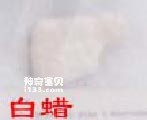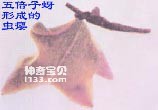Some people may not believe that insects and their by-products can be used as raw materials for industrial production, but this is a true fact.
(1) Shellac
Shellac is also called fire paint, and the trade name of the paint material is shellac sheet. The main component of shellac is shellac resin, which has many excellent properties and has strong adhesion to smooth surfaces such as glass, metal, mica, etc. It is widely used in industry and can be made into film for craft use. It is a high-end paint that dissolves film in 95% alcohol and is used to paint high-end furniture, wood products, and decorations. In addition, shellac is also a raw material for important industrial products such as plastics, conductive insulators, rubber fillers, and moisture-proof agents. It is widely used in military industry, electrical appliances, rubber, ink, leather, plastics, steel, metallurgy, machinery and other industries, as well as wood products. , food, pharmaceutical and other industries.

Where does lac come from? It is the secretion of female lac bugs of the order Homoptera and the family Glycopodidae. The lac bug is a world-famous resource insect. Lac bugs are parasitic on more than 40 kinds of trees and shrubs, including Dalbergia of the Leguminosae family, Ficus of the Moraceae family, large-leaf trees of the Fernaceae family, and jujube trees of the Rhamnaceae family. The origin of lac bug is India, Sri Lanka, Thailand, Vietnam, Indonesia, Philippines and other countries. It is produced in Yunnan, Guizhou, Sichuan, Tibet, Guangdong, Guangxi, Fujian and Taiwan. The largest production area of lac in my country is in Yunnan Province. my country produces hundreds of thousands of kilograms of lac annually. In addition to meeting the needs of the domestic market, some of it can also be exported.
(2) Magenta and rouge
Magenta is a red dye extracted from the red body fluid of magenta worms of the order Magentaidae. Magenta worms are native to Mexico and are tiny scale insects that live on cactus plants. Before the advent of chemical dyes, indigenous people in Mexico discovered this magenta bug and used it as a red dye. Spain introduced it to Europe in 1518 and gradually became an industrial product. The period from 1831 to 1874 was the prosperous period of insect magenta, with production reaching its peak. With the advancement of science and the development of the chemical aniline dye industry, insect magenta dyes gradually declined and were replaced by chemical dyes. But insect magenta is a dye belonging to biological products. It still has unique advantages in coloring food, beverages, biomedicine, cosmetics, etc. because it is safe for the human body, which is unmatched by chemical dyes.
Carmine is an animal dye extracted from the dark red body fluid of the cochineal scale. It is the best raw material for food, biological and cosmetic dyeing. This cochineal insect was discovered in Ningxia in my country in 1979. It is parasitic on the roots of flower sticks, licorice and other plants.

(3) White wax
White wax, also known as worm white wax, is a fine product made from the wax flowers secreted by the male worms parasitizing the privet tree. White wax is a high-molecular animal wax, with wormwood acid and wormwood alcohol ester as its main components. It has a high melting point and strong stability, which cannot be compared with mineral white wax and beeswax. Commercial white wax is white in color, odorless, tasteless, oily and shiny, and hard and brittle in texture. White wax has stable physical and chemical properties. It has the functions of sealing, moisture-proof, rust-proof, durable, light-proof, muscle-generating, hemostatic and analgesic, tonifying deficiency, repairing muscles and bones, etc. It is an important material in military industry, light industry, chemical industry, handicraft and pharmaceutical production. raw material. Such as anti-corrosion polishing of metal products, moisture-proof, rust-proof and lubrication of precision instrument machinery. Because of its high melting point, the models and teaching aids produced will not soften or deform under high temperatures in summer. It is used as polishing agent in the textile industry, filling and polishing agent in the paper industry, anti-corrosion of capacitors, automobile wax, floor wax, raw materials of cosmetics, polishing of luxury furniture, etc. Especially in the military industry, aerospace, scientific research and other departments, white wax is used The demand is increasing day by day.
The use of white wax in ancient my country began in the 13th century, and was only used for candle burning or medicine. Before that, beeswax was used. White wax is produced in all southwestern provinces of my country, with Sichuan and Yunnan being the most productive. According to Cai Banghua's records (1956), only Leshan, Chengdu, and Yibin, the distribution centers of white wax in Sichuan Province, reached 100,000 dans (about 50 kilograms per quintal) in peak years. The annual output is more than 7,000 dans, accounting for 80% of the country's total.
White wax is a traditional product in my country and enjoys a high reputation internationally. White wax is precious and rare. First, it is limited by the production area. In the world, only a few provinces such as Hunan, Sichuan, and Yunnan in China are the main production areas; secondly, it has a wide range of uses. As early as 1615 AD, foreign missionaries conducted investigations into pewter production in my country. In the 19th century, the British consul in China also inspected China's pewter production. In 1922 AD, the Japanese conducted research and experiments on Chinese ash, and the former Soviet Union, the United States, India and other places introduced and propagated it. However, according to data records, at present, only Japan, the former Soviet Union, and India have a small amount of pewter production experiments, and the rest have basically failed.
White waxworms belong to the order Homoptera and the family Scalecidae. The white waxworm is parasitic on more than 20 broad-leaved trees of the genus Ligustrum and Fraxinus in the family Asteraceae. Among them, the ash tree is its main host, so it is called the white waxworm. Ligustrum lucidum is a cold-resistant evergreen small tree with a height of up to 15 meters. However, when used as an insect tree, it can be artificially controlled to about 2-3 meters. It is a good parasitic plant for female insects to survive the winter and lay eggs in early spring. The ash tree is a deciduous tree with a height of 10-15 meters. It can also be controlled to 2-3 meters after cutting off the main trunk. Leaves fall in winter and grow vigorously in summer and autumn, providing nutrients for the growth and development of male insects, making the insects fully developed and producing more wax. There is only one generation of white waxworms per year. After the fertilized female overwinters, she begins to lay eggs in early or mid-March of the following year. The hatched larvae often hide under the mother shell for about 10 days, and then leave the mother shell and crawl up and down among the branches, commonly known as wandering rods. Within 60 days, it can be fixed on the vein of the sunny leaf surface, and the stylet is inserted into the tissue from the vein to suck and grow, which is called fixed leaf. After 20 days, it sheds its first skin and enters the second instar. It leaves the leaf surface and settles down on the first and second-year twigs with its head downward and tail upward, which is commonly known as fixed pole. After 50 days, they shed their skin, turn into adults, and enter the mating and reproductive stage.
Two days after the female larvae appear, the male larvae will crawl out of the mother's shell, crawl upwards and swarm on the shady leaves, sucking and growing. After the male worm establishes leaves, the back of the body gradually becomes covered with white silk. After half a month, they shed their skin for the first time, leaving the leaves and reaching the branches. They cluster head upward one by one under the branches of two or three years old. They no longer move and form wax strips. After four molts, they become adults. After mating, the adults gradually die. This is the time to harvest white wax.

(4)Gall aphid
The gall aphid belongs to the order Homoptera and the family Aphididae. Aphids of this class have no abdominal tubes, or the abdominal tubes are degenerated, and the mouthparts are degenerated. They generally have well-developed wax glands and often secrete a white cotton-like substance, so they are often called woolly aphids or woolly worms. The horned aphid has a body length of 1.5 mm for the winged type and 1.1 mm for the wingless type. It is light yellowish brown or dark green, and its body is covered with white waxy powder. It parasitizes on saltwood, forming irregular insects. It is thin and contains excellent tannins, with a tannin content of 53.41%. It has important uses in industry and medicine and is a famous resource insect.
animal tags:
We created this article in conjunction with AI technology, then made sure it was fact-checked and edited by a Animals Top editor.